Institute for Telecommunication Sciences / About ITS / 2023 / New First-of-Its-Kind Report Provides Analysis of Early CBRS Deployment Data
New First-of-Its-Kind Report Provides Analysis of Early CBRS Deployment Data
May 1, 2023
Today ITS released the report “An Analysis of Aggregate CBRS SAS Data from April 2021 to January 2023,” which presents an analysis of aggregate Citizens Broadband Radio Service (CBRS) Spectrum Access System (SAS) data reported quarterly from April 1, 2021, to January 1, 2023. The data provide valuable insights into the growth of CBRS, the impact of dynamic spectrum sharing, the role of General Authorized Access (GAA) spectrum usage, and CBRS’s role in rural wireless connectivity.
The Citizens Broadband Radio Service (CBRS) band at 3550–3700 MHz was authorized for shared federal–non-federal use in 2015 under an innovative three-tiered sharing system. One unique aspect of CBRS was the introduction of Dynamic Protection Areas (DPAs) in which commercial entrants could dynamically share the spectrum with protected incumbents. DPAs define the areas or points with frequency ranges where incumbent access users are protected from interference. Multiple types of DPAs exist, with different rules for activation. Dynamic sharing is enabled by automated sense-and-avoid Spectrum Access Systems (SASs), which manage the operation of commercial entrants in order to protect incumbent users when and where they operate.
Within the three-tiered CBRS sharing system, incumbent access users, in Tier 1, receive protection against harmful interference from commercial entrants in Tiers 2 and 3. (Permanent incumbent users include all authorized federal users and fixed satellite service (FSS) earth stations.) Tier 2, or the priority access tier, includes Priority Access Licenses (PALs), auctioned on a county-by-county basis in 10 MHz channels from 3550 MHz to 3650 MHz. Devices operating with a PAL must protect and accept interference from Tier 1 incumbents but receive protection from Tier 3 General Authorized Access (GAA) users. Tier 3 is licensed-by-rule to permit open, flexible access throughout the entire band. GAA users must protect and accept interference from Tier 1 and Tier 2 users.
The Federal Communications Commission (FCC) authorized full commercial deployment of CBRS in 2020. In early 2021, after determining the types of data that would be appropriate for sharing with federal regulators to support a longitudinal analysis, NTIA asked SAS administrators to submit operational data on a quarterly basis starting April 1, 2021. To facilitate data quality and anonymization requirements, ITS developed a Python script that SAS administrators used to build aggregate datasets from full activity dump (FAD) data.
Five key findings of the study are:
1. CBRS deployments grew at a steady rate with a mean quarterly increase of 12.0% and a total increase of 121% over the 21-month analysis period. Both indoor and outdoor deployments grew steadily, but over 95% of deployments were outdoors in all quarterly datasets.
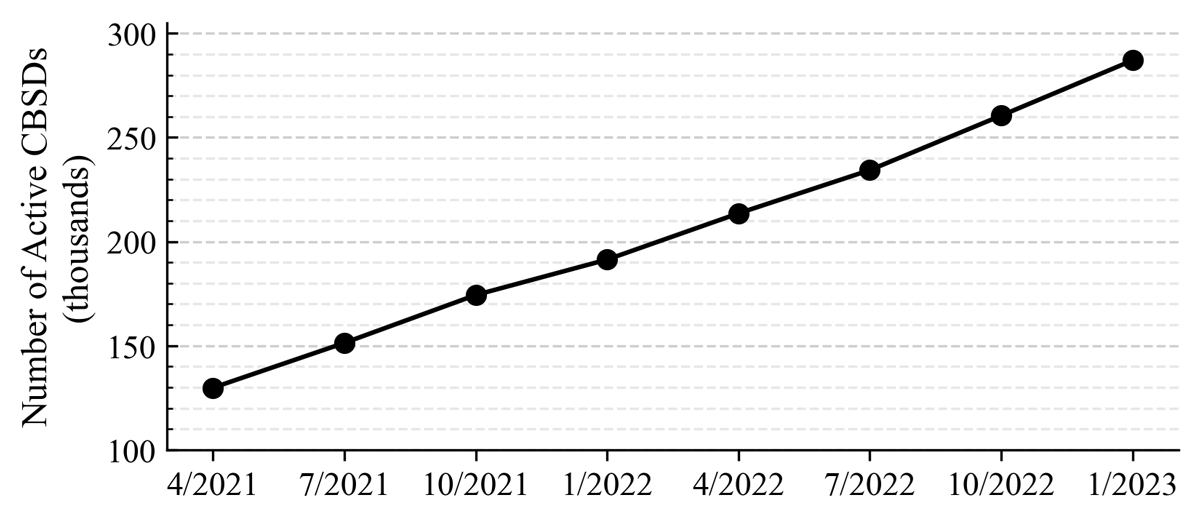
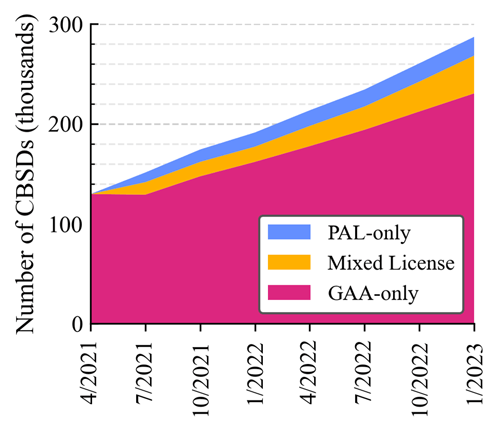
2. The number of CBSDs with Priority Access License (PAL) grants grew consistently with a mean increase of 17% per quarter, but General Authorized Access (GAA) CBSDs dominated deployments. On January 1, 2023, four out of five active CBSDs were GAA-only, 85% of the active grants were GAA, and two-thirds of active CBSDs with a PAL grant had at least one active GAA grant.
3. More than 70% of all active CBSDs were deployed in rural census blocks on January 1, 2023. Over the analysis period, rural CBSDs experienced approximately double the growth of urban CBSDs. Rural areas added 102,340 CBSDs (14,623 per quarter, on average), compared to the addition of 54,893 new CBSDs in urban areas (7,842 per quarter, on average) over the same period.
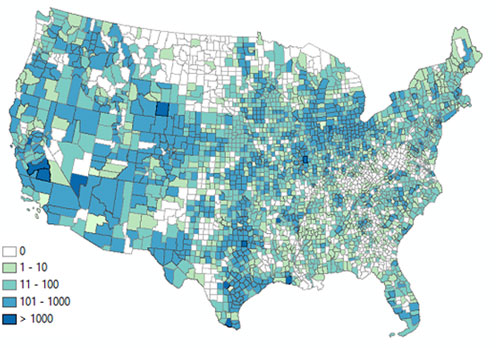
4. CBRS grew in band utilization at the county level. Across all counties, the mean band utilization increased over the analysis period from 5.4 to 9.2 10 MHz channels granted. While demonstrating significant growth in band utilization, the data suggest there is still room to grow.
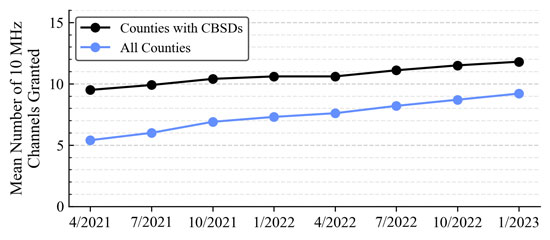
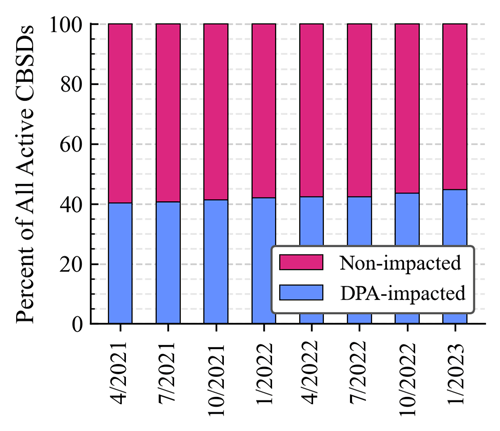
5. On January 1, 2023, there were 128,351 active CBSDs in DPA-impacted counties with a total population of 232,348,897 residents. Had DPA neighborhoods been designated as exclusion zones, those CBSDs could not have been deployed.
This is the first of a longitudinal series of reports from ITS on the CBRS service. A companion study now in its initial phase will deploy sensors to measure how much spectrum CBRS emissions near DPAs occupy over time. Complementary studies such as these, designed in collaboration with stakeholders to analyze spectrum utilization from multiple angles, provide objective data to inform future sharing proposals. An NTIA blog sought input from stakeholders about this newly published report and several stakeholder comments were received.
Figures above are reproduced from TR-23-567, in this order:
- Figure 2: Nationwide number of active CBSDs from 4/1/2021 to 1/1/2023.
- Figure 5(a): Nationwide number of active CBSDs with PAL-only, GAA‑only, and mixed license from 4/1/2021 to 1/1/2023.
- Figure 39: Number of active CBSDs by county for CONUS on 1/1/2023.
- Figure 73: Mean band utilization in each quarterly dataset from 4/1/2021 to 1/1/2023.
- Figure 74(b): Nationwide percentage of CBSDs in DPA-impacted and non-impacted counties from 4/1/2021 to 1/1/2023.




